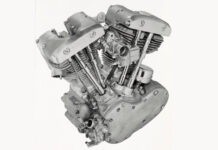
Two of the old Corvettes I have owned over the decadent decades had a nifty little “safety device” in the form of optic fibers in a dashboard indicator that let you know all was well with various exterior lights… notably the taillights.
I was reminded of this when (for what seems like the umpteenth time) I got word of a riding acquaintance who got tagged in the butt on his bike because his brake light wasn’t working… bulb out. He’ll live, banged up as he is… but the $20,000 bike died a premature death for the sake of a single filament on a $2 bulb. Couldn’t help but make the connection between a nearly 50-year-old technology on a sports car and its ability to inform a motorcycle rider of an impending disaster. I mean, there’s virtually no other way to know the most important light on our Harleys… the one that can warn idiots in cages of your intentions… is working. The craziest part is that this kind of simple, potentially life-saving gadget… is non-existent today. Why should that be? In an era of overkill obsession with protecting humans in cars… let alone a poor patsy that rides two-wheelers… how could something as effective as an inoperative light warning system be completely overlooked? Got me thinking…

Nowadays there are light-up little icons in the rearview mirrors of cars, indicating that another two-ton behemoth is close… and in your blind spot… so there really ought to be better ways to keep motorcycle riders informed of similar perils. That’s only one example. Cars get backup cameras, air bags, seat belts, electronic nannies of all sorts… to “save” the average inattentive cage conductor from their own lack of focus on their driving. Sort of chaps my hide that the resulting false sense of security created by all this is all the more reason the dingleberry driver plays with their phone or goofs with the stereo or some combination of the above and thereby threatens the health and welfare of a motorcyclist. What’s worse… is we… us aforementioned motorcyclists… are in serious danger of falling into the same damn trap! We too are provided with infotainment options (a.k.a, “distractions”) galore on our machines. Most of which are OK when you’re in the middle of nowhere and need to stay awake or find out where you really are, or want to whistle or sing along… till you get there. None of which should be touched or toyed with in traffic… yet they are.

Safe and sound?
OK… let’s back up a bit. I’ve always felt that motorcycles are inherently safer than cars. Two reasons. They accelerate faster, stop quicker, maneuver on a whole different plane, are easier to handle in general, much more responsive in every way… need I go on? Secondly, perhaps naively, I feel that the majority of riders are more attentive, skilled, responsible and experienced practitioners of “defensive” driving. (At least the ones who live to ride and ride to live long enough to get some gray hair.) Combine that premise with the tragic reality that at “point of impact” on a motorcycle… all bets are off!
Since the onset of ABS and traction control, not to mention the option of setting “modes (ostensibly for “track days,” rain or snow, and more), the computers on modern motorcycles have assumed control. So, one way to look at it might be that it improves the superior characteristics of motorcycles in order to improve the odds you’ll never encounter a point of impact. But, the same technology decreases the rider demands… and skills. That’s a wash in my book. I mean, the biker who started biking after these nannies were standard equipment, probably has no skills regarding threshold braking, trail braking, feathering throttle or clutch in odd traction situations, and other soon-to-be obsolete tricks of the riders’ trade. Doesn’t need ’em, right? Wrong! Training a rider in skills and techniques is twice the priority that adding pseudo-safety gadgets ever will be. Watch a skilled, experienced rider that can do well without electronic assistance. Then, give him a machine that has them and… wow! Point is, it takes both! Motorcycles have always been the ultimate combination of man and machine. That extraordinary synergy is enhanced when both elements of that equation are as near perfection as possible. Let one go soft and it can be a recipe for disaster… especially when surrounded by other vehicles. Too many variables and too little margin for error!

Inspector Gadget or gadget inspector?
Just as there are devices, electronic and otherwise, that enhance the rider/machine synergy, and those that degrade it, there are plenty that can go either way. It gets a bit complicated and it’s certainly subject to some subjectivity and person tailoring… but it’s true. The trick is to figure out what works for you and your motorcycle. Then dump the rest.
“Safe” is a broad term in the first place, so determining what it means to you… in a dangerous game… requires interpretation.

For me, as an example, the list starts with that tail light bulb warning indicator. I want one! For those with implicit faith in LEDs and reliable brake switches… it might not matter. On the other hand, I don’t much give a damn about loud horns… haven’t used one for defense in decades. In the time it takes to find the button in an emergency, I’d rather have the brake on, or start to steer around, or gas it or some combo… y’know what I mean? Others want a hooter that will wake the dead or make you think they’re the Queen Mary coming out of the fog because an auditory “early warning system” makes ’em feel safer. You see what I’m getting at with this? So it goes… from headlight flashing, to control “feel” at the clutch/throttle/brake interface, tires to antennas… on and on. Riders can land on either side of an argument about each and every aspect of, and all the devices involved in, motorcycle safety and control. The best part in a way, relative to the car folks, is we haven’t had a whole lot of crap forced on us by those who aren’t riders (a.k.a. the government)… yet. That makes these decisions more democratic, but no easier. It’s about what motojournalist Phil Shilling called the “telegraphy” between rider, motorcycle and environment. The late, great Robert Pirsig’s philosophy was also along those lines. He referred to this phenomenon as “reality”… not being what happens with any one thing… but the interplay in all of it. For our purpose here, let’s just say it amounts to striving for an enhanced interface. OK… what’s that look like, specifically?

Stuff that would help… no particular order:
● LED lights—particularly tail light bulbs, since no good outage monitor exists. LEDs react faster, last longer, rob less current from the electrical system and are vibration resistant.
● Tire pressure monitors—since pressure is vastly more critical on motorcycles and people are prone to ignore routine checks. In a perfect world, we’d also have over-inflation reading and a carcass temperature/pyrometer function.
● Rearview mirrors—that give clear, full coverage visibility. I’m not sure these truly exist but they sure should! Proximity warning lights would be a welcome addition… by the way.

● Brake wear indicators—that let you know the facts without the screeching… preferably before it’s too late and without relying on an electronic idiot light.
● Voltmeter/charging indicator—since otherwise you don’t have a clue until it’s too late. Battery life readings would be as helpful as any information about charging system condition, but…
● Oil temperature gauge—which Harley sells and should offer as standard on baggers… need I really explain why? Most hogs built in the last half century run the oil a little hot. Not knowing how hot leads to wasteful over-changing of fluids and premature engine wear (even damage) anyway.
● Engine/cylinder head temperature gauge—because they’re quicker and more accurate for reading spikes in operating temps.
● Engine “hour” meter—since mileage and temperature information aren’t enough. All piston engine aircraft require these… for good reason. Thing is, aircraft typically operate under more or less steady, state conditions. Motorcycles don’t… necessarily! Stop and go, heat and cold, use and abuse… V-twins are much more likely to need maintenance or rebuilding based on time, temperature and treatment. Just ask the dirt bike fans… they use hour meters properly. We should too.

Stuff that really doesn’t… ditto:
● Speedometer—overrated and usually inaccurate. In traffic an unneeded distraction… out in the middle of nowhere… same thing. Odometer and trip meters, on the other hand are handy… especially GPS versions.
● Tachometer—less important than ever with the advent of rev-limiters… they used to help you avoid blowing up an engine from over-revving. Might be good for keeping small, gutless engines in the power band but with a Harley’s torque you’re never out of the power band. Mechanical tachs lag badly and therefore lie… a lot. Electronic tachs on hogs are best used to keep the insensitive rider from lugging the engine… not much more.

● Gas gauges—on carbureted machines anyway—are not as important as a reserve petcock. EFI bikes need something better than low fuel lights… as far as that goes.
● Horns—after all this time, still suck! I can yell louder… and have. Some goon in a cage with the windows up and the tunes cranked ain’t gonna hear you honk. There are ways to correct that defect if you gotta… but just the same.
● Clocks, air temperature gauges (thermometers), oil pressure gauges, high beam indicators, neutral indicators and turn signal indicators—don’t show much, don’t help much and you’d never miss ’em if you didn’t have ’em. At least compared to the information that really matters!
Think. Discuss. Get back…will ya? Thanks!



















